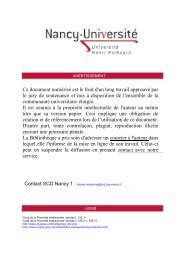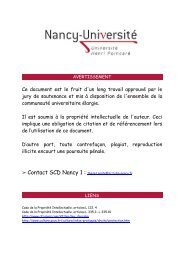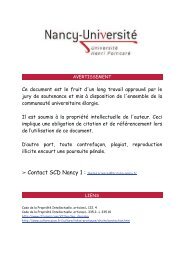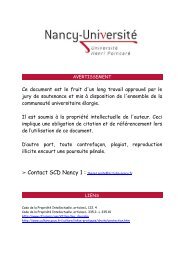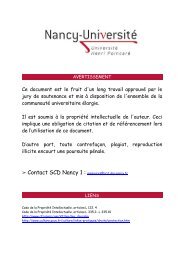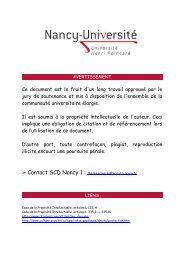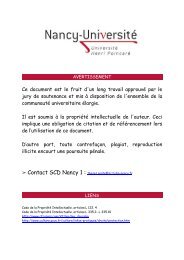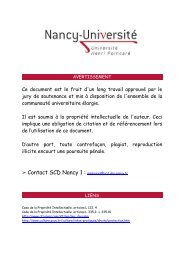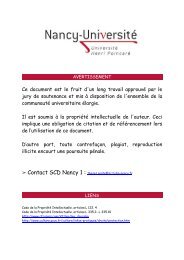Ce document numérisé est le fruit d'un long travail approuvé par le ...
Ce document numérisé est le fruit d'un long travail approuvé par le ...
Ce document numérisé est le fruit d'un long travail approuvé par le ...
Create successful ePaper yourself
Turn your PDF publications into a flip-book with our unique Google optimized e-Paper software.
16 C. Huin et al.! Biology ofthe <strong>Ce</strong>1l94 (2002) 15-27<br />
et al., 1994; Tontonoz et al., 1994, 1995; Schoonjans et al.,<br />
1996; Spiege1man et al., 1997) and monocyte/macrophage<br />
(Marx et al., 1998; Ricote et al., 1998; Tontonoz et al., 1998)<br />
differentiation. Until now, the precise ro<strong>le</strong> of PPAR~ has not<br />
yet been elucidated.<br />
In a recent study (Huin et al., 2000), we have reported<br />
that the PPAR subtypes exhibit different patterns of expression<br />
in relation to morphogenesis and cell differentiation in<br />
the developing human feta1 dig<strong>est</strong>ive tract. Recent reports<br />
indicate that the growth of several different colon carcinoma<br />
cell lines is inhibited by the ligand activation of PPARy<br />
(Brockman et al., 1998) and that transplantab<strong>le</strong> tumors in<br />
mice derived from human colon cancer cells show significant<br />
reduction of growth when mice are treated with<br />
troglitazone, a PPARy ligand (Sarraf et al., 1998). On the<br />
other hand, Lefebvre et al. (1998) have reported that ligand<br />
activation of PPARy in C57BLl6J-APc Mi n/+ mice promotes<br />
the development of colon tumors, and Saez et al. (1998)<br />
found that it acce<strong>le</strong>rates the formation of colonic polyps in<br />
the same mice. Those divergent observations 1ead us to<br />
inv<strong>est</strong>igate the expression of PPARs in the human colon<br />
cancer Caco-2 cells since it has been known that they<br />
undergo spontaneous differentiation in culture when they<br />
reach confluence (Pinto et al., 1983). The PPAR expression<br />
was analyzed by immunocytochemistry, W<strong>est</strong>ern- and<br />
Northern-blotting and SI nuc<strong>le</strong>ase protection assay. The<br />
results indicate that as Caco-2 cell differentiation goes on<br />
characterized by the appearance of bmsh border and peroxisomal<br />
mo<strong>le</strong>cular markers, the protein 1evels of PPARa,<br />
PPARYl and PPARY2 increase gradually. The amount of<br />
PPARY3 mRNA increases concomitantly to the resulting<br />
PPARYl protein. On the other hand, the amounts of PPARa<br />
and PPARY2 mRNA are not significantly changed during<br />
Caco-2 cell differentiation sugg<strong>est</strong>ing that the increase in<br />
their respective protein is due to an e<strong>le</strong>vation of the<br />
translational rate.<br />
2. Materials and methods<br />
2.1. <strong>Ce</strong>l! culture conditions<br />
The human adenocarcinoma cellline Caco-2 was originally<br />
<strong>est</strong>ablished by Fogh and Trempe (1975). <strong>Ce</strong>lls were<br />
cultured in Dulbecco's modified minimum medium<br />
(DMEM) containing 4.5 g 1- 1 glucose, without glutamine<br />
and supp<strong>le</strong>mented with 20% (v/v) heat-inactivated fetal calf<br />
semm (56 oc for 30 min) and 1% (v/v) non-essential amino<br />
acids (all obtained from Eurobio, Les Ulis, France) using an<br />
incubator at 37 oC with a humidified 10% CO2 atmosphere.<br />
The cells (from passages between 85 and 100) were seeded<br />
at an initial concentration of 6 x 10 4 m1- 1 and subcultured<br />
every 5 days. After 5, 10 and 15 days of culture, the cells<br />
were processed for ultrastructural cytochemistry and immunocytochemistry<br />
or frozen in liquid nitrogen unti1 used.<br />
2.2. Ultrastructural cytochemistry ofcatalase<br />
The presence of peroxisomes in Caco-2 cells was inves·<br />
tigated using the procedure of Novikoff et al. (1972), whid<br />
allows the visualization of the peroxisomal catalase activit)<br />
after reduction of alkaline 3,3'-diaminobenzidine (DAB<br />
Sigma Chemical Co, St-Louis, MO, USA). In brief, Caco-:~<br />
cell monolayers were fixed at 4 oC for 40 min in 0.1 M<br />
sodium cacodylate buffer, pH 7.4, containing 2.8% (v/v:<br />
glutaraldehyde, then washed 3 times for 20 min in presencE<br />
of the same buffer containing 7.5% (w/v) sucrose. <strong>Ce</strong>ll~<br />
were treated for 3 h at 37 oC in DAB-medium. The 1attel<br />
was replaced after 90 min. Samp1es were postfixed in lo/c<br />
(v/v) osmium tetroxide buffered with 0.1 M potassium<br />
phosphate, pH 7.4, for 30 min, dehydrated in ethanol and<br />
embedded in araldite/epon (v/v) mixture. Thin sections were<br />
stained with urany<strong>le</strong> acetate and <strong>le</strong>ad citrate according to<br />
Reynolds (1963) and observed with a Philips CM12 e<strong>le</strong>ctron<br />
microscope at 80 kV.<br />
2.3. Enzyme assays<br />
<strong>Ce</strong>ll monolayers were rinsed three times with ice-cold<br />
0.1 M potassium phosphate buffer, pH 7.4, scraped with a<br />
mbber policeman and homogenized in 2 mM Tris/HCl,<br />
pH 7.1, containing 30 mM mannitol. Homogenates were<br />
kept for 1 h on ice, then centrifuged for 15 min at<br />
15000 x g. The supernatants were assayed for protein<br />
concentration according to Lowry et al. (1951) using bovine<br />
semm albumin as a standard. Sucrase-isomaltase<br />
(EC.3.2.1.26) activity was determined according to Messer<br />
and Dahlqvist (1966). Alkaline phosphatase (EC.3.1.3.1)<br />
activity was measured according to Garen and Levinthal<br />
(1960). For both enzyme activity, 1 unit is defined as the<br />
activity that hydrolyses 1 [!mo1e of substrate pel' minute at<br />
37 oC under the experimenta1 conditions. Fatty acylcoenzyme<br />
A oxidase (AOX; EC.1.3.99.3) was determined<br />
using the method reported by Hryb and Hogg (1979) with<br />
homogenates pre<strong>par</strong>ed in 50 mM Tris/HCl, pH 8.0, containing<br />
0.1% (v/v) Triton X-lOO. Lauroyl-CoA (Sigma Chemical<br />
Co) was used as a substrate and the mo1ecular extinction<br />
coefficient was 6930 M- 1 cm- 1 . One unit is defined as the<br />
activity that converts 1 [!mo1e NAD+ into NADH, H+ per<br />
minute at 37 oC under the experimental conditions. Catalase<br />
(EC. 1.l1. 1.6) activity was assayed according to Baudhuin et<br />
al. (1964). One unit 'Baudhuin' (UB) is defined as the<br />
activity that hydrolyses 1 [!mo<strong>le</strong> of substrate per minute at<br />
4 oC.<br />
2.4. Immunoblot analysis<br />
<strong>Ce</strong>ll homogenates were pre<strong>par</strong>ed according to two protocols.<br />
Firstly, Caco-2 cells were homogenized in 20 mM<br />
Tris/HCl, pH 8.0, containing 5 mM EDTA and 1% (v/v)<br />
Triton X-lOO, then centrifuged at 15000 x g for 30 min at<br />
4 oc. The protein concentration of the supernatant was



